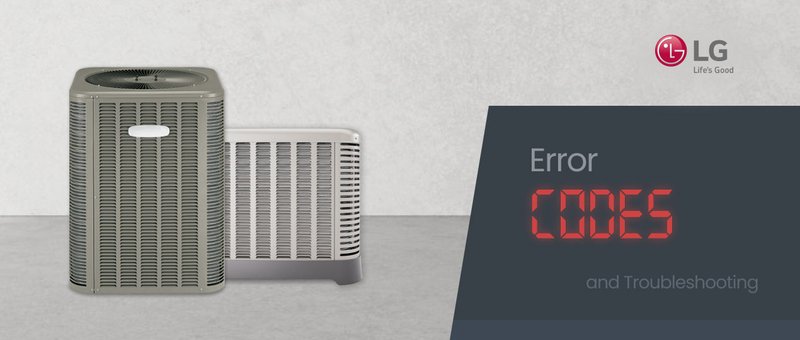
Error codes are the way that modern appliances communicate issues to us, almost like secret messages telling us something isn’t quite right. The SE error code on LG air conditioners is particularly intriguing because it doesn’t directly tell you the problem. Instead, it signals that something within the system is awry, much like when your car’s ‘check engine’ light turns on. The goal here is to demystify this error and provide simple, step-by-step guidance to understand what might be causing it, using language that’s as breezy and clear as a summer day.
Understanding the SE Error Code
Let’s start by breaking down what the SE error code generally indicates. In the world of LG air conditioners, the SE error typically signifies a communication issue between the indoor and outdoor units. Think of it like a phone call where one side suddenly goes silent; something’s wrong with the connection. This disruption can occur due to various factors, ranging from simple things like power surges to more complex issues involving faulty components.
When the SE error code appears, it’s essentially a cry for help from your air conditioner’s system. It’s trying to say, “Hey, something’s not right here!” This error halts the unit’s operation to prevent damage, which means no cool air until the problem is resolved. For many, this cessation is what first catches their attention—especially on a hot day. So, how do you go from seeing this code to enjoying that cool breeze again? By understanding the underlying causes, of course!
Before you start worrying too much, it’s essential to know that this error, while inconvenient, is often not a sign of a catastrophic failure. Most of the time, it involves issues that can be resolved with a bit of troubleshooting. Think of it like having a minor car hiccup—yes, you need to fix it to keep driving, but it’s not the end of your vehicle.
Common Causes of the SE Error Code
The most straightforward cause of the SE error code could be a power-related issue. In many cases, a power surge or outage might disrupt the communication between your AC’s indoor and outdoor units, leading to this error. Imagine trying to have a conversation when someone pulls the plug on your phone; naturally, you’d have trouble hearing each other! When this happens, simply resetting the power can sometimes clear the error code. But remember, just like flicking a light switch, this should be done safely following the manufacturer’s guidelines.
Another common culprit could be faulty wiring or connections. Over time, just like any electronic device, the wiring in your AC can wear down or loosen. When connections get iffy, signals between the two units don’t go through correctly, much like a bad Wi-Fi signal leading to a dropped Skype call. If you suspect this might be the issue, it’s often best to call in a professional to inspect the wiring. Attempting to fix this on your own without the proper knowledge can lead to more harm than good.
In some cases, the problem might lie with the internal components themselves. Just like any complex system, individual parts can malfunction over time. For instance, a faulty control board or communication components within the air conditioner might lead to an SE error. This is akin to having your car’s GPS system fail; you might be driving just fine, but you’re not getting where you need to go smoothly. Identifying which component is causing the trouble typically requires a professional technician who can diagnose and fix the issue accurately.
Troubleshooting the SE Error Code
So, you’ve identified there’s an SE error, now what? The first step in troubleshooting is to try a simple reset. Turn off the power to your air conditioning unit for a few minutes before turning it back on. It’s a bit like rebooting your computer; sometimes, this simple step can clear minor glitches. If after powering back on the error persists, it’s time to delve a bit deeper.
Should the error code still be flashing at you like a stubborn check engine light, it’s time to consider whether the wiring or connections might be at fault. While you can inspect visible wiring connections for signs of corrosion or loose plugs, remember that handling electrical components can be tricky. If you’re not confident, seeking help from a qualified technician is the safest bet.
Finally, if you’ve reset and checked connections to no avail, the issue might lie in one of the components themselves. At this stage, it’s wise to contact customer support or a professional technician. They can offer detailed diagnostics and repairs, ensuring that you’re not just putting a band-aid on the problem but solving it entirely.
Preventing Future SE Errors
Once your air conditioner is back to working order, you’ll want to keep it that way—no one likes dealing with unexpected interruptions! Just like regular oil changes keep a car running smoothly, routine maintenance can prevent many common AC issues, including the SE error code. Scheduling regular check-ups with a professional means minor issues can be caught before they become significant problems.
Additionally, safeguarding your unit from power surges can help prevent communication errors. Investing in a surge protector designed for major appliances can protect the electrical components of your air conditioner from sudden power spikes. This is akin to putting on your seatbelt before driving; it’s a simple safety measure that protects against unforeseen events.
In summary, understanding what the SE error code means and knowing how to troubleshoot it can save you time and hassle. By ensuring regular maintenance and taking protective measures, you can enjoy a cool and comfortable home without unexpected interruptions from your LG air conditioner. After all, who doesn’t love a cool breeze on a hot day without any drama?